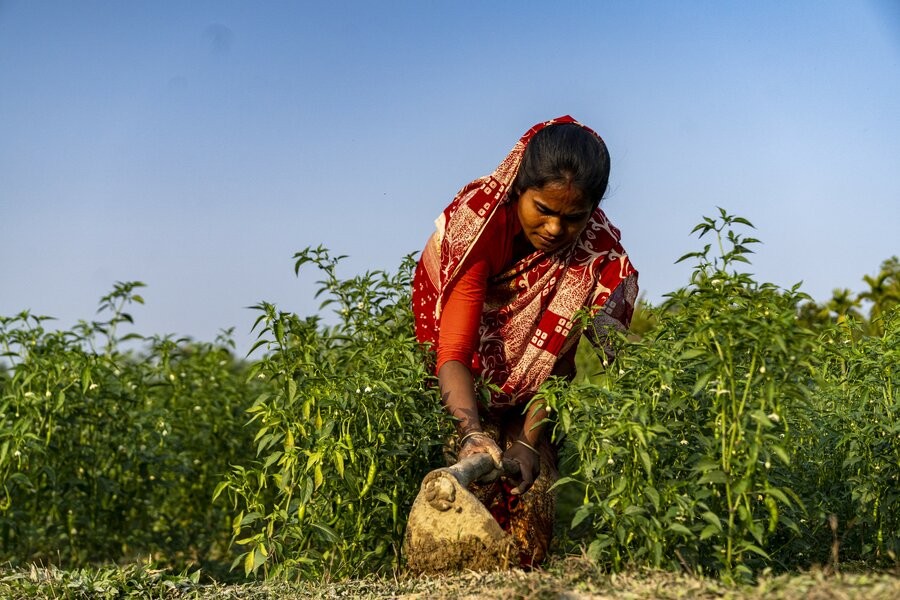The poverty alleviation efforts in rural Bangladesh have floundered following the country's rapid shift from agrarian economy to service and industry sector-led economy, according to a study.
High concentration on a single crop, lack of agro product diversification, knowledge gap about high-value crop and women's unrecognised role in agriculture are the key factors hindering rural poverty reduction, it said.
The researchers suggested reforming agricultural policies to support a more diversified and modernised agricultural production system, introducing high-value crops, and agro skill development to sustain poverty reduction landmarks.
The findings of the study were revealed at the session-8 on the final day of the three-day Annual BIDS Conference on Development (ABCD) 2021 organised at a hotel in the city's Gulshan area.
At the session, findings of four studies were presented that include - "Bangladesh Rural Income Diagnostics" by Maria Eugenia Genoni; "From Jobs to Careers: Apparel Exports and Career Paths for Women in Developing Countries" by Gladys Lopez-Acevedo and Mexico Vergara; "How Selling Online is Affecting Informal Firms in South Asia" by Maurizio Bussolo; and "Women's Employment and Safety Perceptions: Evidence from Low-income Neighbourhoods of Dhaka" by Tanima Ahmed.
Presided over by BIDS director General Dr Binayak Sen, the session was moderated by Professor of the Development Economics at University of Ulster, UK SR Osmani.
Senior Associate of Population Council, New York, USA Sajeda Amin and Chief of Development Research of United Nations Department of Economic and Social Affairs (UN-DESA) Nazrul slam also presented two papers on the occasion.
On the first presentation, Ms Genoni said Bangladesh's progress in reducing rural poverty has been remarkable but the improvements have been uneven.
The country's poverty reduction was mostly driven by agriculture followed by development of service and industrial sectors; though the recent trends show that the service sector has become the key driver of poverty alleviation, she said.
From 2000 to 2005, agriculture contributed about 40 per cent to poverty reduction efforts while the share increased over 70 per cent during 2005-2010.
However, in later years, between 2010 and 2016, service sector accounts for over 38 per cent of poverty reduction on the back drop of lower contribution of agriculture to 28 per cent.
Industrial sector also emerged as a major driver of poverty reduction by contributing about 22 per cent from 2010 to 2016, she mentioned.
At that point, poverty alleviation in rural areas has become somewhat vulnerable due to issues like high rate of self and daily-wage employment, large share of employment in informal sectors and microenterprises, increased rate of rural unemployment especially among youth and women.
Besides, she said the consequences of extreme weather conditions derived from climate change hamper agro output every other year that cause income shock at rural households which they hardly can recover from.
Meanwhile, the country's agricultural production is highly concentrated on single crop paddy rice with 71 per cent dependency.
With few diversification options and farmers' knowledge gap about high-value agro products, income growth in such households remains stagnant, she said, adding: "Participation of rural women in formal rural economy has been very low making economic inclusion harder."
Of women who work, about 60 per cent are in agriculture, with a large proportion taking care of livestock or engaged in unpaid agricultural activities.
The rural labour market is tightening, as evidenced by the agricultural wage growing faster than the general wage rate, making it tougher for women to participate in formal economic activities, the study showed.
As part of policy recommendation, she identified five priorities to help raise incomes of rural poor including -- repurposing agricultural policies to support a more diversified and modernised agricultural production system, continue to improve water management, access and quality of electricity, and road accessibility, expanding the quality of skills and extension services, and address gender norms that constrain women's work opportunities.
At another presentation on "women's employment and safety perceptions", Ms Tanima said concerns about safety and security play a significant role in determining women's mobility and their entrance to labour market.
According to the National Survey on Violence against Women, 2015 by the Bangladesh Bureau of Statistics (BBS) 18.3 per cent of women identify public spaces (vehicles, roads, street) as a place where sexual violence occurs.
Besides, another survey by ActionAid in 2016 reports that 84 per cent of Bangladeshi women routinely experience insults or sexual comments while in public spaces.
Under such circumstances, women are less likely to participate in the labour market, she said adding: at the same time women's level of education also impacts the perception of safety in public space.
Women with higher education level and from affluent family background feel safer at workplace while a woman with lower education level and from risky geographical location feel less safe to enter economic activities, she added.


